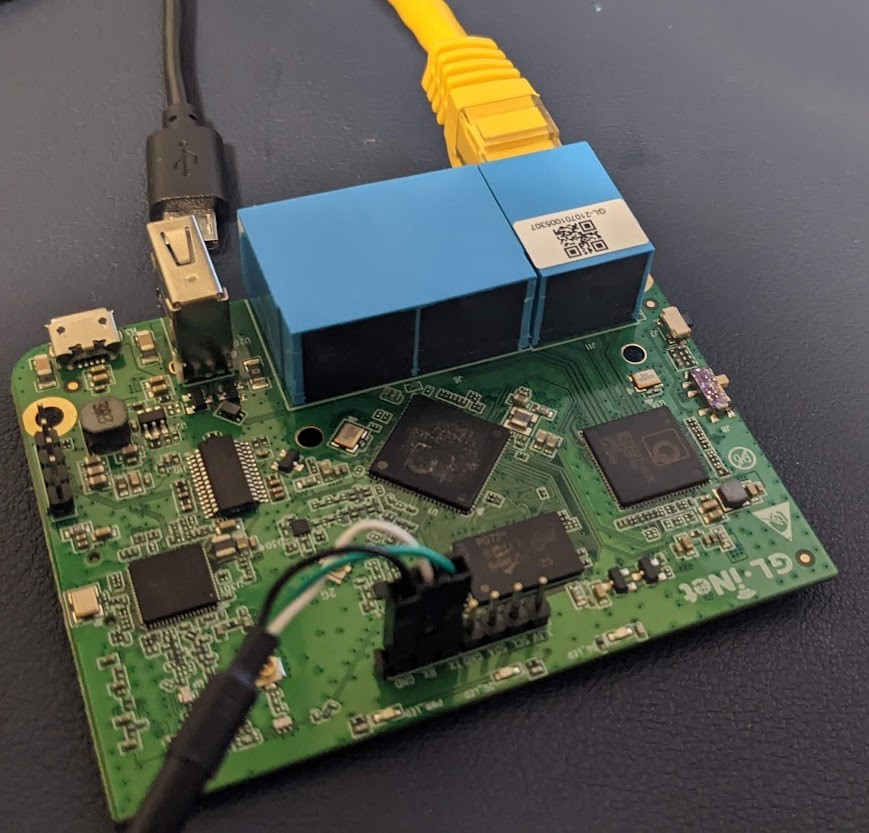Hacking the GL-AR750S, Part 1: Physical Compromise
Hacking the GL-AR750S, Part 1: Physical Compromise
Ever since I started hacking in 2020, I’ve mainly stayed on the software side of things - digital forensics, web exploitation, and some binary exploitation through CTFs. I won 2nd place at my local security conference (SAINTCON) in 2021, and received a GL-AR750S-EXT travel router as one of my prizes. It’s intended to be a secure middleman that allows you to use public/open WiFi with encryption. I never really needed to use it, and it sat on my shelf for about a year before I decided to test it for vulnerabilities.
I had seen and even done a little bit of hardware hacking before. I knew what UART and JTAG were, and had worked with serial connections. The process that I followed to physically connect to the device is outlined here on OpenWRT.org. Like it says, I removed the dot feet, unscrewed and opened the case, removed the antennaes, extracted the PCB from the case, and removed the heatsink. Then, using my roommate’s soldering iron and connectors, I soldered on 7 pins for the I2C and UART connectors, and used a UART-to-USB adapter to connect my laptop to the PCB.
My setup:


More photos of the inside of the GL-AR750S can be found here.
Once physically connected, I opened up PuTTY on my machine, and established a Serial connection through the USB adapter at a 115200 baud rate (which I found by looking at the datasheet for the QCA9563 chip). Upon powering it on, a lot of boot information flew across my screen (see the full text at boot.txt):
1 | U-Boot 1.1.4 (Fri May 17 09:44:06 2019) |
Pressing ENTER revealed a root shell, no password required!
1 | BusyBox v1.30.1 () built-in shell (ash) |
After some research and discussing with peers, this is fairly common actually. The industry “default” I guess you could say is to assume that if someone gets physical access to a device, it’s been compromised. This is a prime example - just a little physical finangling, and you have full, unrestricted access to the device with all current data. Now, the root user does have a password, which is actually the same password as the admin account on the GUI (see the documentation), but it never asked you for it. Go figure. Apparently GL.iNET knows about it and doesn’t intend to fix it \o/.
My next goal was to copy all the files onto my local machine so I could examine them, especially the web source code. I found that the machine was running Dropbear, a very small SSH client/server on port 22. I connected my laptop to the board using an Ethernet cable in one of the two LAN slots, and found I was able to SSH onto the machine with the root account and password. Note that I did have to use the command ssh -oHostKeyAlgorithms=+ssh-rsa root@192.168.8.1, since Dropbear only supported ssh-rsa, not allowed by default. I then used SCP to copy all the contents of the chip to my machine (using the command scp -r -oHostKeyAlgorithms=+ssh-rsa -O root@192.168.8.1:/folder . for compatibility reasons).
Now that I had remote access to the machine and source code to work with, I was ready to start looking for vulnerabilities!
To read about the 7 CVEs I later discovered, hop on over to Part 2!